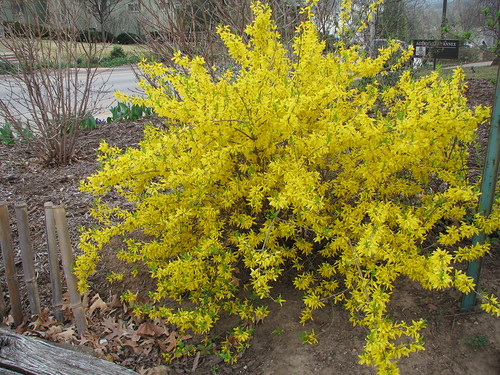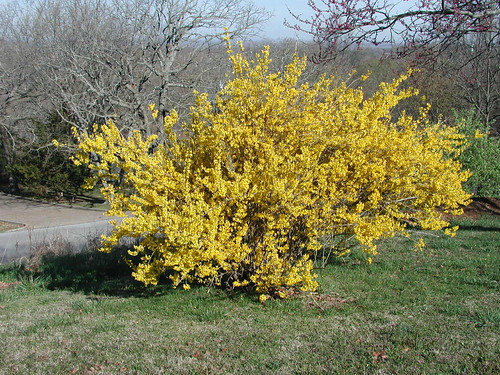Resource Library
Plant of the Week: Pruning forsythias
(632 words)
FAYETTEVILLE, Ark. -- I’m a sucker for the bright gaudy yellows and golds of forsythia. Many “garden authorities” disparage their use in the garden because they are so commonplace and easy to grow. They cloak their criticism by saying that forsythia is a “single season” shrub with no interest the rest of the year, but in their heart of hearts I’ve always suspected it was their mundane nature that led to the shunning. However, to grow forsythia well, some attention must be paid to pruning or the beauty of these wonderful shrubs can be easily lost.
The most commonly seen forsythia clones such as ‘Spectabilis,’ ‘Lynwood Gold’ and ‘Spring Glory’ are large plants often growing 8 feet tall and 12 feet or more wide. However, as with most plants, the size characteristics can be modified by their surroundings. While the aforementioned size characteristics may be correct for a plant grown out in the center of the lawn in full sun, crowd it amongst a border of other large shrubs and small trees and the nature of the plant changes at it will grow taller with less spread.
To bloom their best forsythia need at least six hours of full sun. With less sunlight they will still bloom but some of the show will be sacrificed. The best displays occur when they are planted by themselves as a large sprawling screen where they more or less allowed to do their thing without intervention. However many of us don’t have room in our gardens to give them unlimited space, so some size control is needed.
If forsythia plants are growing where their size is not an issue, they will bloom each spring without problems. If their size needs to be controlled, prune them severely just after they finish blooming. By severely, I mean just that. Large, never-before-pruned shrubs can be cut back to within a foot or two of the crown using loppers or a chain saw if needed. These are not delicate shrubs so don’t worry about all the “pruning rules” you’ve read about cutting back to an outward facing bud and other such nonsense.
After pruning regrowth will be fast and furious, so it will be prudent to keep the fastest of the new shoots pinched back to allow the slower growing shoots to create a uniform flush of growth. I would not fertilize the plant because that will only encourage their vigorous ways. Flower buds begin forming in mid-July so any branches cut off after that time will sacrifice blooms for the following spring. By pruning back hard once every two to four years, size can be controlled to a manageable level and the natural shape of the plant maintained.
The worst way to prune forsythia is with hedge shears. Hedging destroys the natural beauty of the shrub and limits the number of blooms to a thin mantle of blooms on the sheared surface. The most beautiful shrubs have blooms throughout the plant, up and down the stem.
Another approach to pruning is to look for some of the many dwarf forsythia clones that are now on the market. Dwarf forsythia got a bad name when first introduced because they didn’t bloom much. More modern dwarfs versions such as ‘Fiesta’, ‘Goldilocks’, ‘Gold Tide’ and ‘Show Off’ are in the 4 to 6 foot tall range and better suited to most gardens. Unfortunately these slower growing clones don’t make as good a showing at the nursery as their larger, more exuberant brethren so often get passed over for the too-large kinds everyone plants. Expect the dwarves to take three or four years to achieve sufficient size to show what they can do. However, once they do, pruning will be much less of a traumatic and brushy event.
For more information about horticulture, or to see other Plant of the Week columns, visit extension’s website,http://uaex.uada.edu/yard-garden/resource-library/plant-week/or contact your county extension agent.
Pursuant to 7 CFR § 15.3, the University of Arkansas System Division of Agriculture offers all its Extension and Research programs and services (including employment) without regard to race, color, sex, national origin, religion, age, disability, marital or veteran status, genetic information, sexual preference, pregnancy or any other legally protected status, and is an equal opportunity institution.

